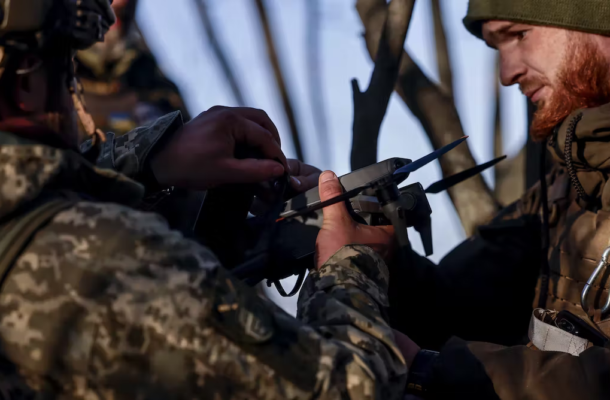Drones bring Russia into range for Ukraine

NATO secretary-general Jens Stoltenberg spoke recently of his fear that the war in Ukraine could spin out of control into a full-blown confrontation between Russia and the west. “If things go wrong, they can go horribly wrong,” he told Norwegian broadcaster NRK.
Stoltenberg’s remarks came on December 9, a few days after Ukraine is thought to have launched a series of drone strikes at airbases deep inside Russian territory. The following day, December 10, Russia reportedly used Iranian-supplied drones in response, attacking the key southern port city of Odesa and leaving 1.5 million people without electricity. Since then, the air war has further escalated.
Russia and Ukraine have deployed a wide range of military and commercial drones since the early days of the war. But their increasingly frequent – and effective – deployment indicates a potential new stage of escalation with important consequences for Ukraine and its western backers.
Both sides have used drones in a variety of roles, including intelligence gathering and combat operations. They have also been used for the documentation of war crimes, and by journalists reporting from otherwise inaccessible war zones.
While much of the emphasis has been on the use of aerial combat drones carrying out strikes against Russian forces from the air, Ukraine has also deployed drones successfully against Russian naval assets in occupied Crimea. In this particular attack, aerial drones were coordinated with marine drones, which work similarly to more traditional torpedoes.
Another relatively new feature in the war in Ukraine is the widespread and highly effective use of small commercial drones, many of them operated by civilian volunteers to gather intelligence. This has contributed to increasing the situational awareness of Ukrainian forces, identifying Russian positions and monitoring troop movements.
The now-abolished international special monitoring mission to Ukraine pioneered this use of drones in the country to check on the ceasefire established by the first of the failed Minsk agreements of September 2014. But the sheer scale of their use after the beginning of the Russian invasion dwarfs anything that happened before February 2022.
Will drones help Ukraine win?
Clearly, the Ukrainian use of drones shows the benefits of this technology. Drones have a longer range than many of the missiles Ukraine has in its current arsenal. They are cheaper, don’t require the same level of training that aircrews in manned aircraft would need, and don’t put Ukrainian troops at the risk of loss or capture.
Drones thus provide a means to penetrate deep into Russian and Russian-occupied territory, extending Ukraine’s reach to several hundred miles behind the current frontlines. Even if the damage inflicted in the recent attacks inside Russia was only slight, it served as an important demonstration of Ukraine’s offensive capabilities. Their ability to evade air defences exposes yet more Russian vulnerabilities and serves as an important, morale-boosting tactical victory.
At the same time, it is also a psychological blow for Russia that demonstrates Ukrainians’ ability to hit the enemy at home and to answer drones with drones. And it demonstrates, too, that earlier doubts about the effectiveness of Ukrainian drone warfare was based on overestimating Russia’s air defence capabilities.
Yet, for now, drones have not decisively shifted the course of this war in Ukraine’s favour in a strategic sense. For that to happen, Ukraine will need more capable air defence systems against the kamikaze drones Russia currently deploys to devastating effect against infrastructure and civilian targets.
And drone attacks alone are unlikely to inflict the losses and damage necessary for Russia to end its invasion. Ukraine will also need more long-range artillery and missile systems which can deliver more powerful strikes against Russian bases and installations, both in occupied territory and in Russia itself.
At the same time, supplies of drones from Russia’s most important military backer, Iran, need to be more effectively curtailed.
Is escalation inevitable?
US secretary of state Antony Blinken said Washington had “neither enabled nor encouraged” Ukrainian drone strikes against military bases in Russia (although the US defense department is reported to have at least tacitly approved the attacks).
Throughout the war to date, NATO has been keen to avoid escalation beyond Ukraine, and this has included limiting the equipment and arms that have been supplied to Ukraine. Ukraine’s drone strikes against military facilities inside Russia do not necessarily signal the end of this strategy. Targeting the bases from which cruise missiles were launched at Ukraine is a legitimate defensive tactic to limit these strikes.
But it also shows a wider willingness on the part of Kyiv to attack Russia beyond occupied Ukrainian territories and at least tacit western approval of such an approach. Moscow will have to plan on that basis, allocating scarce military resources to the defence of key targets far from the front line. This will limit further Russian capacity to defend illegally annexed Ukrainian lands, let alone to escalate the intensity of its current efforts to capture more territory in Donbas.
Properly integrated into a wider Ukrainian and western military strategy, drones could in this way be an important contribution to forging a path towards Russia’s defeat.
This article was written by Stefan Wolff and David Hastings Dunn, a Professor of International Politics at the University of Birmingham. It was published by The Conversation UK.
The author of eighteen books and over fifty journal articles and book chapters, Stefan Wolff is Professor of International Security at the University of Birmingham, England, UK who specialises in the management of contemporary security challenges.













